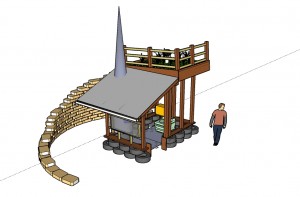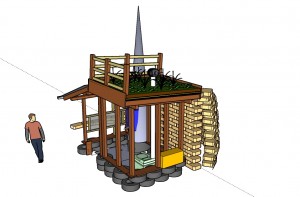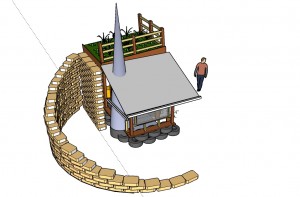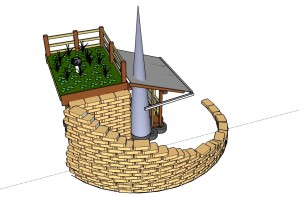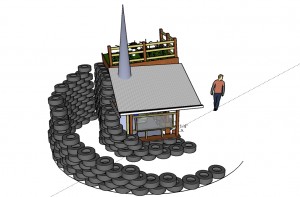
After drawing the earthberm ramp to the living roof with tires of rammed earth, I saw that it would take about 150 pounded tires to create a retaining wall for the earthberm ramp. Recalling the May 2011 strawbale build for the llama shed, it took us a day and a half with 11 people to pound the 47 tires in the foundation. At that rate, it would take us at least 4 or 5 days just to build the retaining wall! That’s a lot of tire pounding for such a small structure.
In an effort to solve the issue of “how do we avoid pounding tires for 5 days”, I searched the internet for other ideas. I found out that someone has built a retaining wall by stacking unopened cement bags in a running bond. When it rained, the moisture was sucked in through the paper bag and voila, a cement brick wall was formed! It’s a great idea, but at $5 per bag and with at least 200 bags necessary for the wall, it’s well out of budget for this project.
The next “easy way out” idea I had was to just set strawbales in place for the retaining wall, cinch them together, use the usual mud mixtures on them and fill in the ramp. I knew this idea sounded far-fetched because I suspected the outward pressure of the soil against the wall would be too great for the weight of a strawbale wall. I searched Andrew Morrison’s strawbale.com to see if others had ever tried an earthberm strawbale wall, and Andrew suggests that any buried wall be made of concrete block or something similar that then transitions to unburied strawbale walls. Concrete blocks are also out of budget for this project, at $3 per block and about 125 blocks, we’d be at $375 just for the retaining wall.
And, of course, there is the classic milled stone retaining wall. If we can’t afford bags of concrete or concrete blocks, I know milled stone is out of the budget.
Then, the idea of earthbags entered my mind. My neighbor has been toying with the idea of earthbag construction for a while and has a book that he’s let me look through. Filling bags with earth seems like an easier process than pounding tires, and I have access to free burlap sacks from a local coffee roasting company. Perhaps the smell of coffee will stimulate the crew to fill them faster! The earthbagbuilding.com website indicates that burlap bags will rot with moisture, but I think that since most of the earth material at Blue Rock Station is clay, it will form bricks that stay in place and rotting burlap should not affect the integrity of the structure. The sacks would then be covered with the traditional mud mixtures and the interior face of the retaining wall will have a vapor barrier of 6 mil plastic similar to the one used in the foundation of the building. If the deterioration of the sacks are a concern for Annie & Jay, we can use woven polypropylene feed sacks available from any large scale agricultural operation. I’ve located a few examples on Craigslist for about $0.19 a piece.
My model indicates that it would take about 225 earthbags to build the retaining wall. I haven’t timed how long it would take to fill an earthbag, but my guess is that it would take less time to fill 225 earthbags than to pound 150 tires.
Another addition to this rendition of the model is the tin roof from with rainwater is diverted to a rainbarrel within the bottle-wall cone. A drainage system for this handwashing station is yet to be devised, but I envision a sink built into the wall with PVC piping draining away from the building to a French drain.
Below are the latest images from the model:
